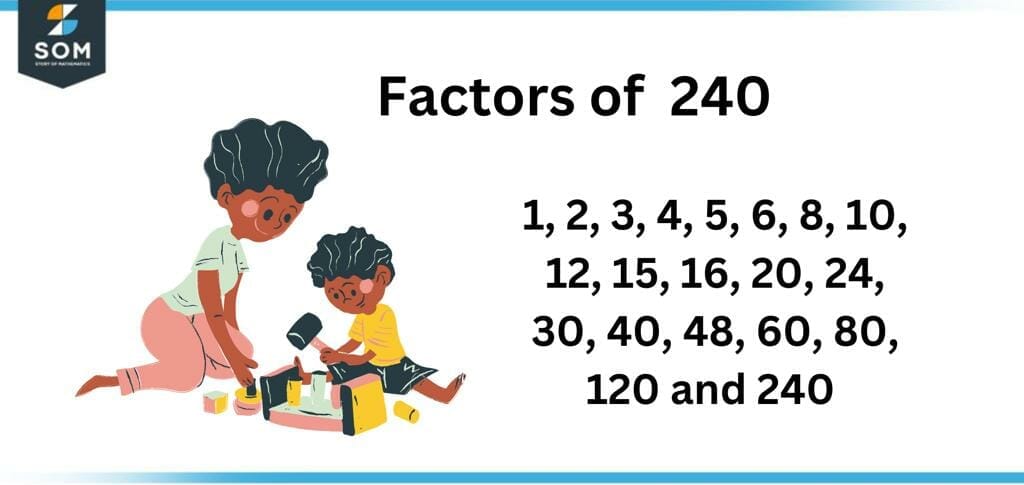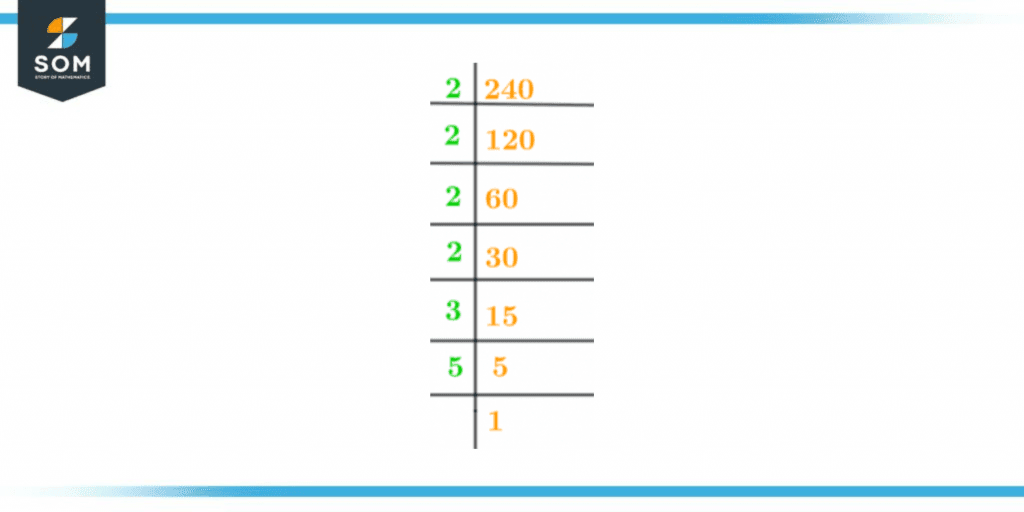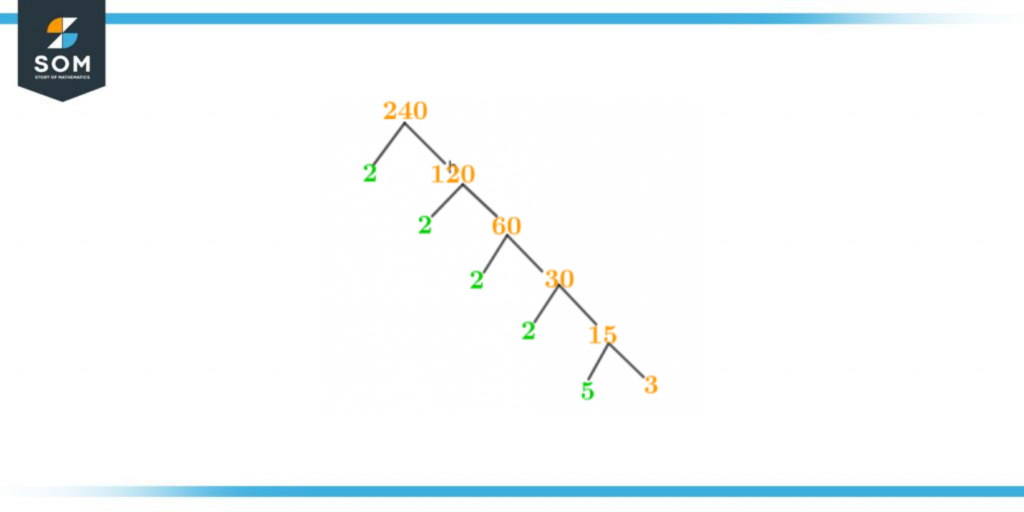JUMP TO TOPIC
Factors of 240: Prime Factorization, Methods, Tree, and Examples
Factors of 240 refer to the numbers that have two qualities when divided by the following number. They should always give a whole number as the answer and should give off no remainder once the division process has been completed.
Figure 1 – All possible Factors of 240
What Are the Factors of 240?
The factors of 240 are 1, 2, 3, 4, 5, 6, 8, 10, 12, 15, 16, 20, 24, 30, 40, 48, 60, 80, 120, and 240. All the numbers mentioned give no remainder when divided by 240.Another quality the Factor of a number should have is that when divided by 240, it should never result in decimals or fractions. The factors mentioned above can be divided into factor pairs by multiplying them. When multiplied, two numbers that will give 240 as the answer will be called a factor pair of 240.How To Calculate the Factors of 240?
You can find the factors of 240 using either the multiplication or division process. Let’s look at both methods to choose the best one for yourself. For both methods, the first thing is to make sure that you know what the numbers are less than or equal to, as only such numbers can be called the factors of 240.Then, if you want to use the division method, start by dividing each number by 240. Only the numbers that will give no remainder and the answer will be an integer will be called the factor of the number.For a clearer concept, let’s look at a few examples: \[ \frac{240}{2} = 120 \]\[ \frac{240}{3} = 80 \]\[ \frac{240}{4} = 60 \]As you can see that each of the divisions done above answers whole numbers. Thus, all the dividing numbers 2, 3, and 4 and their answers 120, 80, and 60 will be considered as the factors of 240. The number 240 has 20 factors that are mentioned below: Factors list of 240 includes 1, 2, 3, 4, 5, 6, 8, 10, 12, 15, 16, 20, 24, 30, 40, 48, 60, 80, 120 and 240 as factors.We are moving further to how we can find factors using multiplication. It is as easy as the other method as well. You have to find out what two numbers when multiplied together, give off the answer 240. In this method, the multiplying numbers are considered factors of the specific number. Let’s take a few examples now:1 x 240 = 240
2 x 120 = 240
3 x 80 = 240
4 x 60 = 240
Thus it proves that factors can also be found this way without any error. The number’s factors occur in pairs; therefore, their product equals 240.Factors of 240 by Prime Factorization
There are multiple methods used to represent the factors of a number. Amongst many, Prime Factorization is one of the most used methods to represent a number as a product of its prime factors. You can represent an integer as a product of its prime factor using Prime factorization very easily. Let’s take a quick overview of the method and how to represent it on a diagram: Start with diving at the smallest prime number by dividing the number. Mostly, the smallest prime number is either 2 or 3 of any number. The number 2 is the smallest prime number of 240; thus will divide it by 180. Take a look at the following division below:\[ \frac{240}{2} = 120 \]If possible, you must divide the same prime number further or move on to the next one. \[ \frac{120}{2} = 60 \]Continue the same step till it gets simplified to the extent that no prime number can further divide the factors into whole numbers. You cannot just represent the prime factorization of a number using a diagram but can also denote it mathematically. The notations for 240 are:2 × 2 × 2 × 2 × 3 × 5= 240
The diagram of the Prime factorization of 180 can be seen below:
Figure 2 – Prime Factorization of 240
Factor Tree of 240
Prime Factorization isn’t the only easy way to represent the factors of a number. Using a Factor Tree is another way to graphically describe a number’s prime factors. A factor tree is made so that the number marks the start of the factor tree, and its factors continue through extending branches. The factor tree ends once you reach the smallest prime number of a number. You’ll quickly figure out that 2, 3, and 5 are considered to be the prime factors of 240 by prime factorization. Therefore, the final integers represented at the end of this numbers factor tree will be 3 and 5. The Factor Tree of the number 240 can be seen below:
Figure 3 – Factor Tree of 240
- 240 is a semiperfect number, which means it equals the sum of all its proper divisors. Thus, it is also called an imperfect number.
- Though, by now, you already know that it is a composite number, the remarkable fact is that it has more factors than any of the previous numbers on the list, i.e., 20 factors!
- This number is also refactorable as it has 20 factors total, and the number 20 is also divided by 240.
Factor Pairs of 240
A Factor pair is made when two numbers are multiplied together, and the answer we get is the number we are working on. There are two Factor pairs- Negative factor pairs and positive Factor Pairs. As the name suggests, there is no significant difference in both types of factor pairs, as even if you can find one, only the signs of all numbers must be reversed. Let’s look at the factor pairs of the number 240:1 x 240 = 240
2 x 120 = 240
3 x 80 = 240
5 x 48 = 240
6 x 40 = 240
12 x 20 = 240
15 x 16 = 240
16 x 15 = 240
24 x 10 = 240
30 x 8 = 240
40 x 6 = 240
48 x 5 = 240
60 x 4 = 240
80 x 3 = 240
120 x 2 = 240
240 x 1 = 240
The positive factors of 240 are given as follows:(1, 240)
(2, 120)
(3, 80)
(4, 60)
(5, 48)
(6, 40)
(8, 30)
(-0, 24)
(12, 20)
(15, 16)
Thus, there are ten positive factor pairs of 240, and when their signs are reversed, they will become the negative factor pairs of 240 too.The negative factor pairs of 240 are given as:(-1, -240)
(-2, -120)
(-3, -80)
(-4, -60)
(-5, -48)
(-6, -40)
(-8, -30)
(-10, -24)
(-12, -20)
(-15, -16)
Factors of 240 Solved Examples
Example 1
What is the sum of all the factors of 240?Solution
List down the factors of 240 first that are given as follows:Factors of 240: 1, 2, 3, 4, 5, 6, 8, 10, 12, 15, 16, 20, 24, 30, 40, 48, 60, 80, 120 and 240
Add all the factors.The sum is given as:Sum = 1 + 2 + 3 + 4 + 5 + 6 + 8 + 10 + 12 + 15 + 16 + 20 + 24 + 30 + 40 + 48 + 60 + 80 + 120 + 240
Sum =744
Thus, the sum is 744.All images/mathematical drawings are made by using GeoGebra.